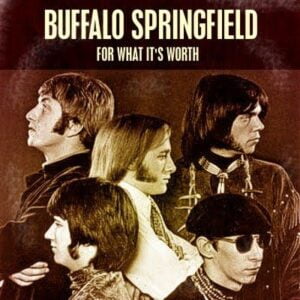August 9, 2024 —– Chart #258
Hello Music Friends,
Hey folks, welcome to another edition of Chart of the Week. In case you haven’t figured this out yet, I love everything about Crosby Stills Nash & Young, and all their predecessor bands. Today we have one of the early groups. “For What It’s Worth (Stop, Hey What’s That Sound)” (often referred to as simply “For What It’s Worth“) is a song written by Stephen Stills. Performed by Buffalo Springfield, it was recorded on December 5, 1966, released as a single on Atco Records in December 1966 and peaked at No. 7 on the Billboard Hot 100 chart in the spring of 1967. It was later added to the March 1967 second pressing of their first album, Buffalo Springfield. The title was added after the song was written, and does not appear in the lyrics. In 2004 Rolling Stone magazine ranked the song at number 63 on its list of the 500 Greatest Songs of All Time.
Although “For What It’s Worth” is often considered an anti-war song, Stephen Stills was inspired to write the song because of the Sunset Strip curfew riots in Los Angeles in November 1966, a series of early counterculture-era clashes that took place between police and young people on the Sunset Strip in Hollywood, California, the same year Buffalo Springfield had become the house band at the Whisky a Go Go. Local residents and businesses had become annoyed by how crowds of young people going to clubs and music venues along the Strip had caused late-night traffic congestion. In response, they lobbied Los Angeles County to pass local ordinances stopping loitering, and enforced a strict curfew on the Strip after 10 p.m. The young music fans, however, felt the new laws infringed upon their civil rights.
On Saturday, November 12, 1966, fliers were distributed on the Sunset Strip inviting people to join demonstrations later that day. Several of Los Angeles’s rock radio stations also announced a rally outside the Pandora’s Box club on the corner of Sunset Boulevard and Crescent Heights. That evening, as many as 1,000 young demonstrators, including future celebrities such as Jack Nicholson and Peter Fonda (who was handcuffed by police) gathered to protest against the curfew’s enforcement. Although the rallies began peacefully, trouble eventually broke out. The unrest continued the next night, and periodically throughout the rest of November and December, forcing some clubs to shut down within weeks. It was against the background of these civil disturbances that Stills recorded “For What It’s Worth” on December 5, 1966.
Stills said in an interview that the name of the song came about when he presented it to the record company executive Ahmet Ertegun (who signed Buffalo Springfield to the Atlantic Records-owned ATCO label). Stills said “I have this song here, for what it’s worth, if you want it.” Another producer, Charlie Greene, claims that Stills first said the above line to him, but credits Ahmet Ertegun with giving the single the parenthetical subtitle “Stop, Hey What’s That Sound” in order that the song would be more easily recognized. The song was recorded on December 5, 1966, at Columbia Studios, Hollywood. One of the most recognizable elements of the song is Neil Young’s use of guitar harmonics.
Play it. Sing it. Have a good time pretending to be Stephen Stills for a few minutes. Jam on!
Keep Rockin’,
Stan Bradshaw
